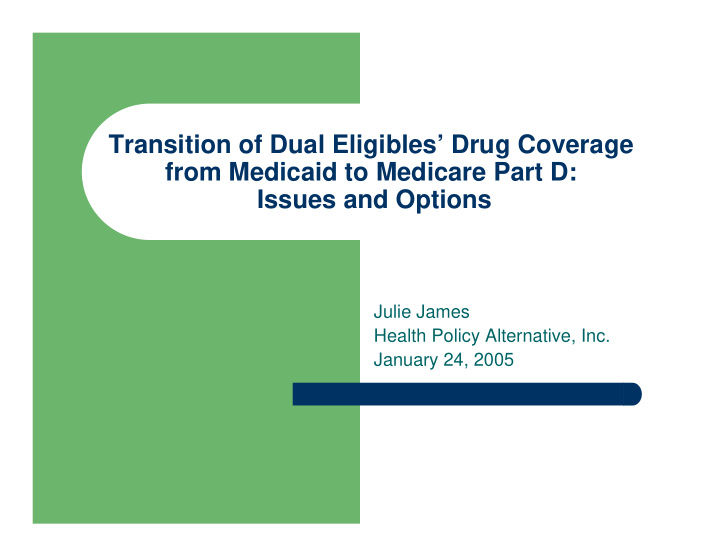



Transition of Dual Eligibles’ Drug Coverage from Medicaid to Medicare Part D: Issues and Options Julie James Health Policy Alternative, Inc. January 24, 2005
Implementation: Realities � Legislation cannot anticipate all implementation and timing issues � “Technical corrections” are often needed – Through legislation – Through administrative action � Examples: – Y2K delayed implementation of some of BBA – IRS provided transition relief HSAs
Major Problem Areas � Avoiding gaps in coverage for dual eligibles in transition from Medicaid to Medicare – Beneficiaries must understand plan in which enrolled and how to use it � Continuity of therapy and access to drugs
Options for Enrollment Issues 1. Keep Medicaid drug coverage for dual eligibles 2. Delay implementation of Part D for duals for specified period (1 year?) • All duals or subset (e.g., institutionalized) 3. Retain Medicaid FMAP for drugs for duals until enrolled in Part D 4. Auto-enrollment and verification initiatives
Option 1: Keep Duals in Medicaid � Denies access to Medicare benefit for some Medicare beneficiaries � Would cost states money; save federal dollars � May save beneficiaries cost sharing $ � Already considered as part of Senate bill and rejected
Option 2: Delay Part D Implementation for Duals � Duals would be held harmless in the short-term – Retain Medicaid drug coverage (exclude from Part D) – May save them copay $ � Allows more time to transition the most vulnerable � May negatively affect plan participation, bids and premiums for non-duals – 6.4 million fewer enrollees in Part D plans � Would cost states/save federal dollars � May increase political pressure to maintain status quo � Alternative: delay for a subset of duals
Option 3: Retain Medicaid FMAP For Duals Until Enrolled In Part D � Allows duals the entire open enrollment period to select plan – Although law allows duals to change plans at any time � Would need incentives to encourage duals to enroll as soon as possible – Maintain auto-enrollment � Would cost states/save federal money
Option 4: Auto-Enrollment and Verification Initiatives � Auto-enrollment – Assign all duals to a plan before end of 2005 – they are allowed to switch plans anytime – Provide notice through pharmacies to duals at time of refills during last quarter of 2005 � Provide systems to verify enrollment for plans and pharmacies – Plan ID cards may be late/lost � Enhanced education and outreach
Options to Assure Continuity of Therapy and Access to drugs 1. Require plans to have open formularies for duals or exempt duals from utilization tools for period of time 2. Allow states to get FMAP to cover off- formulary drugs as “wrap-around” 3. Allow Medicaid to encourage and cover 90 day refills in December 2005
Option 1: Require Temporary Open Formularies For Duals � Allows time for duals to transition to other drugs • May be costly to plans and/or non-dual enrollees because compromises ability to negotiate prices and encourage cost-effective drug utilization • Could create disincentive to enroll dual eligibles � Other options: • “Grandfather” Medicaid Rx: require plans to provide one initial refill of any Medicaid covered drug regardless of formulary • Require plans to provide a temporary “emergency” supply while an appeal is pending
Option 2: Allow States To Get FMAP To “Wrap Around” Part D � Allows for continuity in drug regimen - Administratively complicated � Would require process to determine plan coverage vs. Medicaid � Would cost states money/may save federal dollars � May discourage plans from more comprehensive formularies
Option 3: Allow and Encourage 90 Day Medicaid Refills in December 2005 � Allows time for transition to new coverage without interrupting therapy � Would require significant administrative/education effort for states � Would cost states money/save Medicare dollars � May encourage unnecessary 90 day refills – Could be limited to specified maintenance drugs
In Sum � There is precedence for legal or administrative changes to facilitate transitions � There will be cost implications for any change (states, Medicare, plans, and/or enrollees) – Not impossible to address � Without change, some risk that transition will not be seamless
Recommend
More recommend